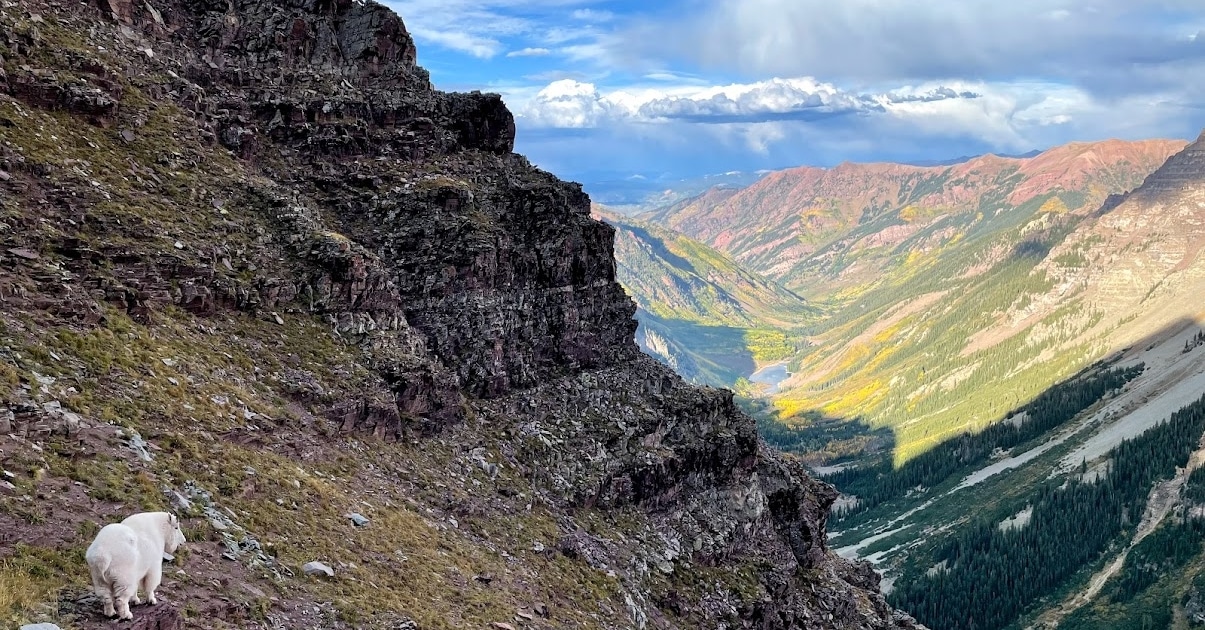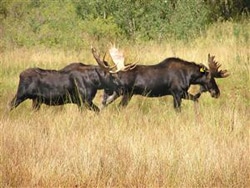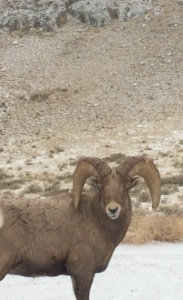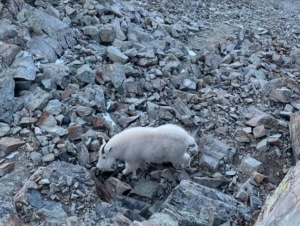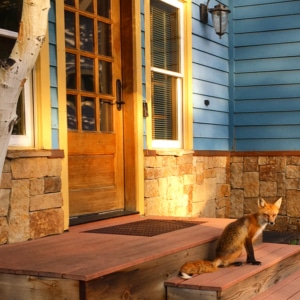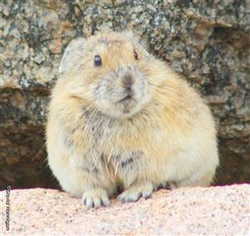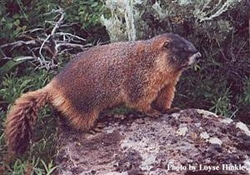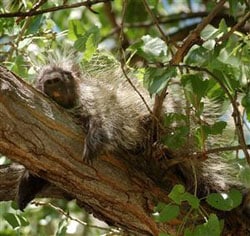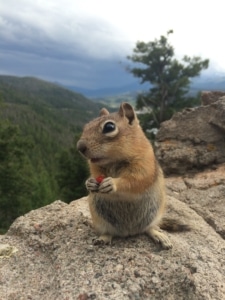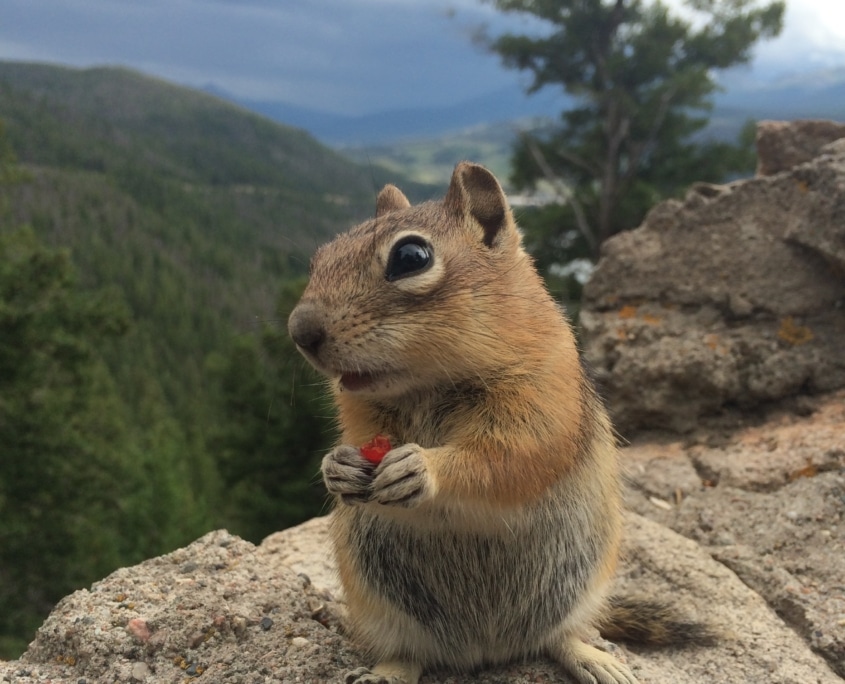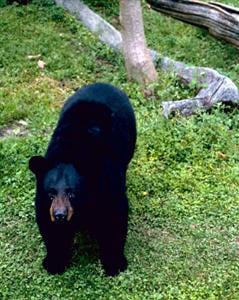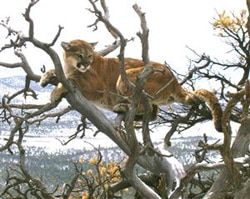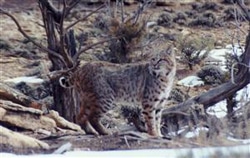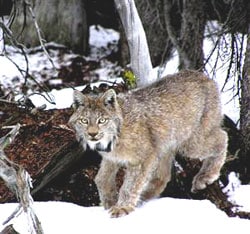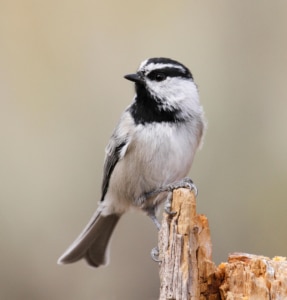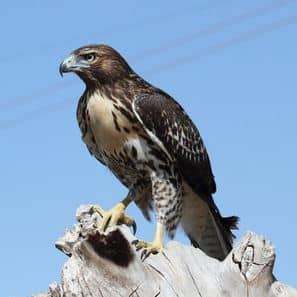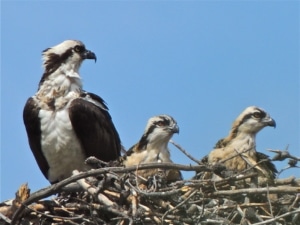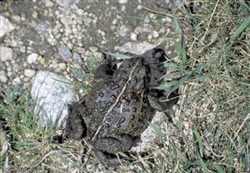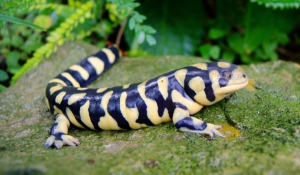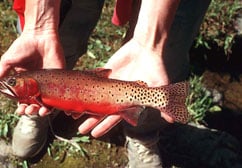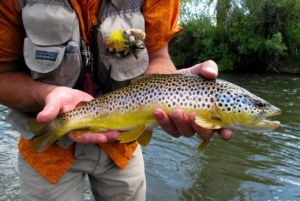One of the things the many things that make Colorado so magical is the assortment of creatures that call the centennial state home! From the trout that swim in our rivers to evasive big cats, from gigantic moose to the tiny chipmunk, our wildlife is varied and plentiful. While there are hundreds of species in Colorado, these are a few that can be found in or around our mountain community. On your next trip to the mountains, keep your eyes and ears open for these amazing animals. Remember to respect their space and keep the wild, wild!
Information for this post was gathered from Colorado Parks & Wildlife. Learn more about CPW here!
Hoofed Mammals
Moose
Alces alces
Moose are the largest mammals in Colorado- over six feet tall at the shoulder! Transplanted to the state in 1978 and 1979, breeding populations of moose can now be sighted in most higher elevation habitats. Moose prefer to live in forested areas that are close to lakes or marshes. Their diet consists of grazing on willows, grasses, bushes, leaves, needles, and underwater vegetation.
It is important to note that moose are very territorial and will aggressively defend their space and young when disturbed.
Deer
Genus Odocoileus
Colorado is home to two species of deer- mule deer and white-tail deer. Mule deer have longer rope-like tails, large ears, and are a lighter tan color. White-tail deer have smaller ears, medium-brown color, and white tails. Both species are approximately three to four feet high at the shoulder. Mule deer are especially abundant all over the state. They prefer habitats along rivers and woodland. Deer feed on forest vegetation such as twigs, leaves, shrubs, trees, etc.
Bighorn Sheep
Ovis Canadensis
The bighorn sheep is Colorado’s official animal- home to the largest population anywhere in the world! They are approximately five feet long and three feet tall at the shoulder. Bighorn sheep are gray-brown with a pale belly and white backend. The male rams have enormous coiled horns that can make up to ten percent of their body weight! There are two species of bighorn sheep in the state. Rocky Mountain bighorn is native and the desert bighorn was introduced in 1979. Bighorn can be found occupying mountains and foothills throughout the state but they prefer steep, high mountain terrain. Bighorn sheep like to graze in meadows and alpine tundra.
Mountain Goat
Oreamnos Americanus
Mountain goats were are also an introduced species! In 1947, fourteen goats were transplanted from Montana to expand hunting opportunities. Additional goats were later introduced from Idaho, South Dakota, and British Columbia. Mountain goats have thick shaggy white coats, short horns, and black eyes. Males can weigh up to 250 pounds! Mountain goats stay in high mountain ranges and habitats, rarely venturing below treeline. Their diet consists of grasses, mosses, lichen, and shrubbery.
Elk
Cervus Elaphus
Elk are a native species to Colorado. Elk are a huge deer species- weighing up to 900 pounds! Elk are brownish tan and brown with a dark mane around the shoulders. Males have very large antlers. Elk can be found in all mountainous parts of the states and graze meadows and alpine tundra. They live in large herds that can number up to several hundred individuals. Elk mainly diet upon grasses, but during winter will also eat twigs and shrubs.
Small Mammals
Red Fox
Genus Vulpes
Red foxes are very common in Colorado and you will likely see one here in Summit County! These cute little creatures are about three feet long and only weigh about ten pounds. They have redish-orange fur, darker legs, a light chest and underbelly, and long bushy tails. Foxes live in a wide variety of environments and have an equally varied diet. Foxes eat smaller animals such as rodents, rabbits, and birds. Additionally, they will also eat insects, fruits, and eggs from nests.
Red foxes around Breckenridge are used to humans, but it is important to never feed foxes! Not only is this inherently dangerous to the species, it is also illegal.
American Pika
Ochotona Princeps
The pika is a small mammal of the high alpine that looks like a mix between a rodent and a rabbit. You will likely hear their shrill “chirp” before you spot them! Pikas are rock-gray in color and blend in well with their environment. They are roughly the size of a guinea pig- approximately eight inches in length and weighing only about half a pound. During summer hikes, you will likely see these little creatures once you are above the treeline. They live in alpine talus and rockpiles and eat vegetation from alpine meadows- storing their food for the winter months.
Yellow-Bellied Marmot
Marmota Flaviventris
Marmots are the largest of the squirrel species in Colorado and look similar to woodchucks and beavers. Yellow-bellied marmots are about two feet long and weigh about ten pounds. They have grizzly-brown fur with a yellowish belly. Marmots have a broad habitat. They are often spotted in alpine meadows but will live in lower foothills as well. Marmots build their dens deep below large boulders, burrowing throughout their winter hibernation. Marmots like to eat flowers, grasses, and other plants.
Porcupine
Erethizon Dorsatum
Porcupine can be found throughout Colorado but this creature prefers wooded, brushy habitats and are most commonly found in woodlands of ponderosa or pinyon pine. These mammals have a diet of bark and herbs. Porcupines are about two and a half feet long and can weigh up to 33 pounds! They have a thick coat of quills that serve as protection. A threatened porcupine can spin quickly and slap its tail. Their quills are needle-sharp and barbed- not something you or your pet would want to come face-to-face with! It is important to keep dogs on leash to avoid an unhappy encounter.
Chipmunk
Benus Tamias
There are five species of chipmunk in Colorado (Colorado, Hopi, Uinta, Cliff, and Least). These teeny little rodents are only about two ounces but can be up to nine inches long. They have large cheek pouches to carry food to store in their burrows. Chipmunks are very common throughout the state and very tolerant of people. Chipmunks eat seeds, berries, flowers, and insects, storing their food for winter. A good place to see these little creatures in summer is Sapphire Point! As tempting as it may be, avoid feeding chipmunks as this will alter their natural food storing and hibernation habits.
Marten
Martes Americana
Martens are a species of weasel that lives in trees. They appear similar to a ferret- their long, slender bodies can be two feet long and weigh only 1.5 pounds. They have brown fur with a yellow-orangeish belly. These animals are nocturnal, hunting squirrels, voles, and birds during the night. They prefer to live in forests of spruce, fir, or lodgepole pine.
Beaver
Castor Canadensis
Beavers are considered a rodent- and a huge one at that! They can be more than three feet long and weigh up to 55 pounds! They have brown, waxy fur and a broad, furless, flat tail along with webbed feet. Beaver live in lakes, ponds, and marshes throughout the state, but prefer to live in the subalpine zone. Their diet consists of grasses and plants in summer, and bark during the winter. Their favorite snack is the tender upper branches of trees such as aspens or willows. If you spot a dam or gnawed tree stumps, keep your eyes open for a beaver!
Carnivores
Black Bear
Ursus Americanus
Despite its name, Black Bear refers to the species rather than the color. Black bears can be honey, blonde, brown, cinnamon, or black. Black bears are common throughout the mountainous regions of the state and are the largest carnivore in Colorado. Males can weigh 275 pounds, and females weigh 175. Bears are foragers and eat berries, nuts, seeds, and insects. It is important to make sure you are disposing of garbage in bear-safe trash cans or dumpsters and avoid leaving food in your vehicles! Bears will change their habits to seek out human food once they have been introduced by careless human handling.
Mountain Lion
Felis Concolor
This big cat is Colorado’s largest- males are more than six feet long and weigh over 130 pounds and are tannish in color. They are carnivorous and voracious hunters- consuming about one deer per week. Their habitat in Colorado is primarily in foothills, canyons, and mesas but can be found in high-mountain environments as well. They prefer brushy areas or woodlands. They are very stealthy- you are very unlikely to spot one!
Bobcat
Felis Refus
The mountain lion isn’t the only big cat that calls Colorado home! Even stealthier than the mountain lion, the bobcat is very secretive. They are about three feet long and look very similar to the lynx. Bobcat is very common in North America and their habitat ranges from Canada to central Mexico. They are found statewide in Colorado. Most commonly they are found in foothills, mesas, canyons, and plateaus. Their favorite food is rabbits, but will diet on any small mammal- they aren’t picky!
Lynx
Lynx Canadensis
The lynx disappeared from Colorado around 1973 but has been successfully reintroduced! Reintroduction began in the remote San Juan mountains and the animals have spread throughout the high country. Similar in appearance to the bobcat and often mistaken for spotted mountain lion cubs, lynx are 20-30 pounds, grayish and spotted. They have very recognizable tufts of fur on their ears. This carnivorous species also feast on small mammal prey such as snowshoe hare. Their huge hind feet help them move through the snow!
Gray Wolf
Canis Lupus
The gray wolf or timberwolf no longer live in Colorado. Wolves once fed upon bison, elk, deer, rabbits, rodents, and more. After large mammals such as bison were decimated, wolves turned to livestock to supplement their diet. Because of this, wolves were eradicated throughout the state. There have been proposals and legislation to reintroduce wolves to Colorado. Wolves could help to restore wilderness ecosystems to provide a check for populations of elk and deer. Many ranchers are opposed to reintroduction. Follow this Colorado Parks & Wildlife page for up-to-date information on reintroduction.
Birds
Mountain Chickadee
White-tailed Ptarmigan
Lagopus leucura
The white-tailed ptarmigan is a small species of grouse with expert camouflaging ability! They are white in the winter and brown-gray in the summer to blend in with their rocky environment. They live in alpine environments above the treeline. Although they can fly, ptarmigans prefer to walk to conserve energy. They primarily eat leaves, seeds, fruit, flowers, and insects.
Bald Eagle
Haliaeetus Leucocephalus
The bald eagle is a bird of prey that everyone can recognize! They have a dark brown body, distinctive white head, and yellow beak. Bald eagles are huge with a wingspan of 6-7 feet. Found only in North America, the bald eagle habitat ranges from Alaska all the way to Florida. Bald eagles were threatened in the mid-twentieth century due to loss of habitat and pesticides, but after protections were put in place, populations have greatly improved! Bald eagles prefer to live near water, near large lakes, rivers, or oceans. In Summit County, bald eagles can be found near Lake Dillon.
Red-tailed Hawk
Buteo Jamaicensis
Red-tailed hawks are another bird of prey that can be commonly found in Colorado. These birds live in a variety of habitats and prefer open spaces. They have red-brown feathers and a yellowish belly. Red-tailed hawks primarily eat rodents, but occasionally rabbits, snakes, or birds.
Crow
Corvus Brachyrhynchos
Crow is common throughout all of North America, including Colorado. Crows are jet black with a metallic violet, blue-violet, or blue-green gloss. Crows are about 20 inches in length with a wingspan of about 35 inches. Their diet consists of grains, seeds, fruits, nuts, insects, snails, small reptiles, frogs, eggs, and more. Their habitat is extremely varied from forests, to farmlands, urban areas, shores, and more.
Osprey
Pandion Haliaetus
Osprey can be found in Colorado in the spring and summer but migrate south for the winter. Osprey has a white head, chest, and belly. Their back and wings are dark brown and have black stripes. These are large birds with a wingspan of 5-6 feet. This bird of prey almost exclusively eats fish. They build their nests high in trees, on rocks, or on platforms. In Summit County, they are most often spotted north of town, when you are heading towards Kremmling.
Fish & Amphibians
Boreal Toad
Bufo Boreas
The boreal toad is Colorado’s only alpine species of toad! They usually live between 8,500 and 11,500 feet in mountain lakes, ponds, wetlands. The Cucumber Gulch area is a protected habitat for the boreal toad. They grow to be approximately 10 centimeters and have warty skin with a light stripe down the middle of their back. Boreal toads feed on insects, flies, mosquitos, grasshoppers, beetles, and moths.
Tiger Salamander
Ambystoma Tigrinum
Tiger Salamander is Colorado’s official state amphibian! They have smooth, moist, sticky skin, a long tail, and four toes on each foot. They can grow up to 14 inches long! They are patterned with black and yellowish stripes or spots. Their habitat ranges across the state from low river valleys to high mountains. They primarily live in lakes, reservoirs, ponds, and pools.
Cutthroat Trout
Oncorhnchus Clarki Pleuriticus
There are several species of cutthroat trout that make their home in our beautiful rivers. The three native species are Colorado River Cutthroat, Greenback Cutthroat, and Rio Grande Cutthroat. These species can all be distinguished by the distinctive red marking along their “throat” as well as spotting along their body, concentrated at the tail. These species can be found in high lakes, streams, and rivers.
Brown Trout
Salmo Trutta
Brown trout are a species that has been widely introduced across much of the world, having been introduced to the US from Germany in 1883. Brown trout are medium-sized fish with brown-olive bodies. They are covered in dark spots surrounded by a lighter halo. They have a diet of larvae, pupae, insects, invertebrates, frogs, and more. Brown trout are a favorite of fly-fishers and anglers!
Rainbow Trout
Oncorhynchus Mykiss
Rainbow trout grow to approximately 20-30 inches in length and weigh about eight pounds. As their name suggests, rainbow trout are very colorful! Depending on their environment, rainbow trout can be blue-green or yellow-green and have a pink streak down their side. They are also speckled with black spots. Rainbow trout thrive in the cold water rivers, streams, and lakes of Colorado and eat small insects, crustaceans, and small fish.
Arctic Char
Salvelinus Alpinus
This species of cold-water fish was introduced to the Lake Dillon Reservoir in 1990. They are generally greenish-brown with light spots and a lighter belly, but their appearance can vary depending on environmental conditions. In 2017, the state record for the largest arctic char was caught by a woman on Lake Dillon! Read more about the story here.

